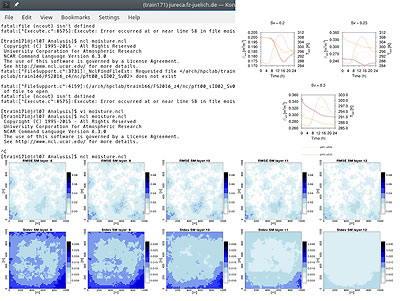|
|
|
| Picture: Analysing modelling results |
Terrestrial Modelling and High-Performance Scientific Computing
October 10-14, 2016, Bonn
The Fall School Terrestrial Modelling and High-Performance Scientific Computing, which I attended in October, was organized by the Center for High-Performance Scientific Computing in Terrestrial Systems (HPSC TerrSys) and supported by the Geoverbund ABC/J.
We started the week with three interesting key note talks on applications of high performance computing in hydrology, climate science and georesources. This was followed by hands-on exercises, which were continued on Tuesday by setting up a coupled model of the terrestrial system (soil, land surface and atmosphere) with ParFlow, CLM and COSMO. The exercise included the whole process from compiling, preparing the input data and running the model to analysing and discussing the modelling results. Throughout the week lectures by experts and hands-on sessions were well mixed, which made understanding and remembering the content of the lectures easy, as well as kept concentration up.
Further topics included the coupling of component models, parallel performance and scaling studies, big data processing and visualization. On Thursday, I switched my role from student to a supervisor for the exercises. The topic was Ensemble Data Assimilation, which I deal with for my PhD.
The course was very well prepared with meaningful and instructive programming exercises which perfectly supplemented the diverse lectures. I got a comprehensive overview on methods of scientific computing and modelling of the earth system, as well as insights in several specific topics. Thanks to all of the organizers and the IRTG for the grant!
PhD student: Dorina Baatz
Project D7: Catchment Tomography
IBG-3: Agrosphere, Forschungszentrum Jülich











